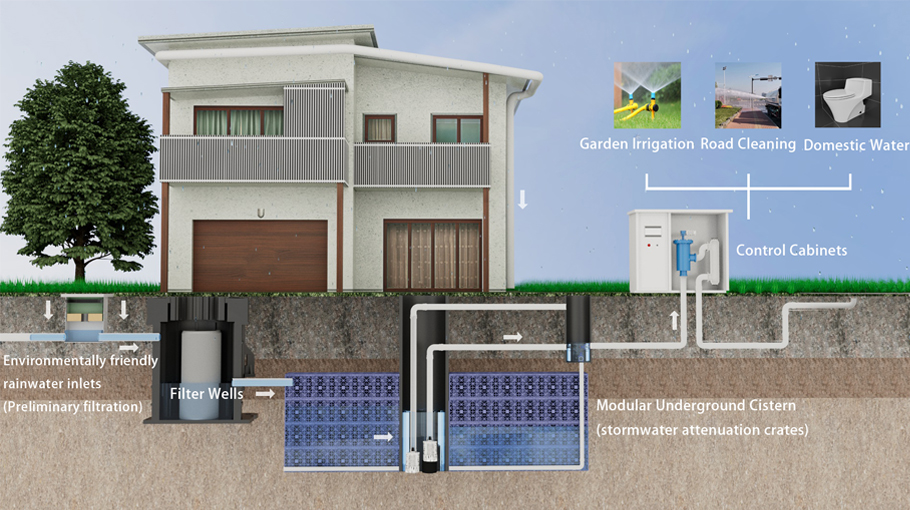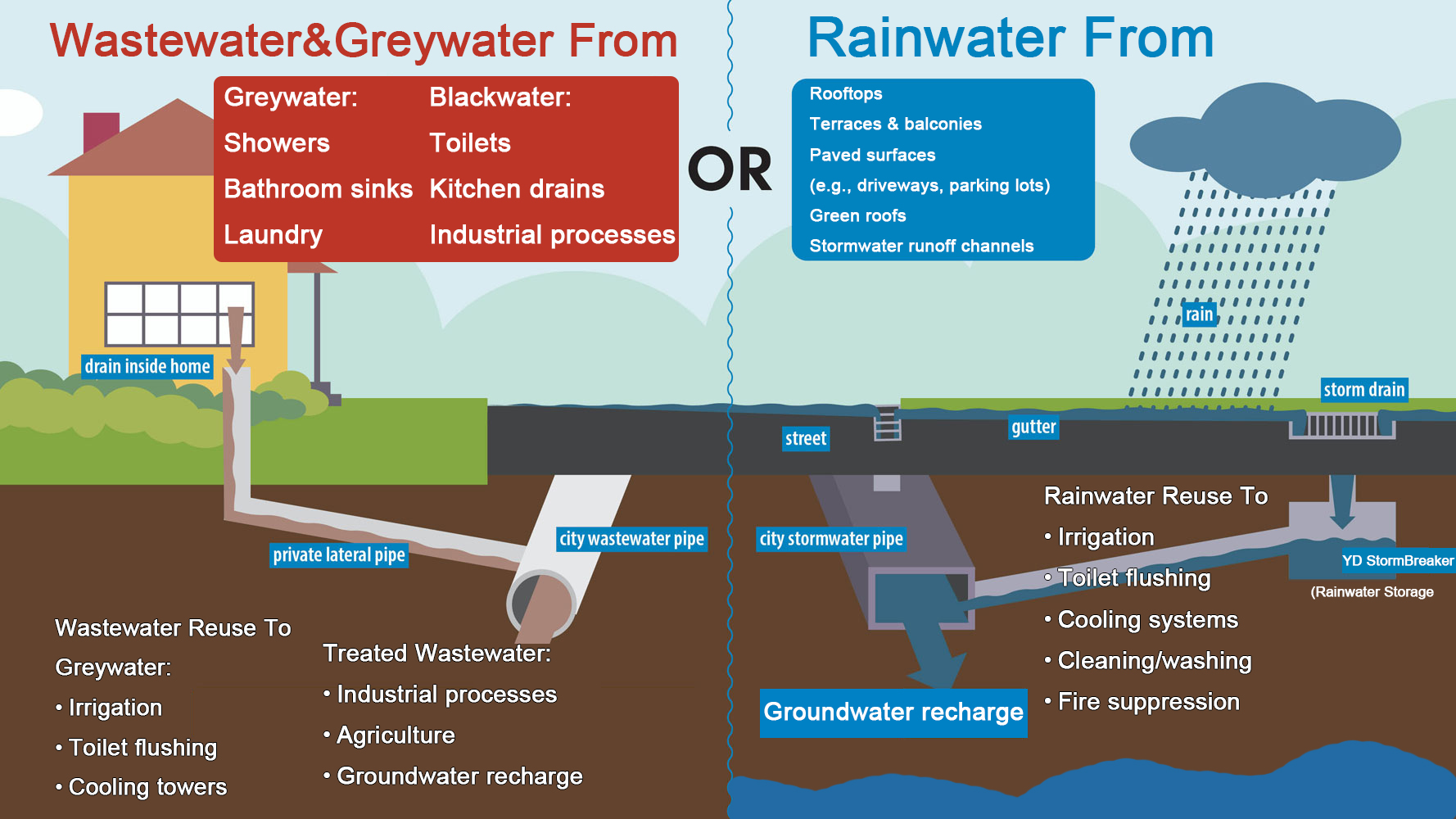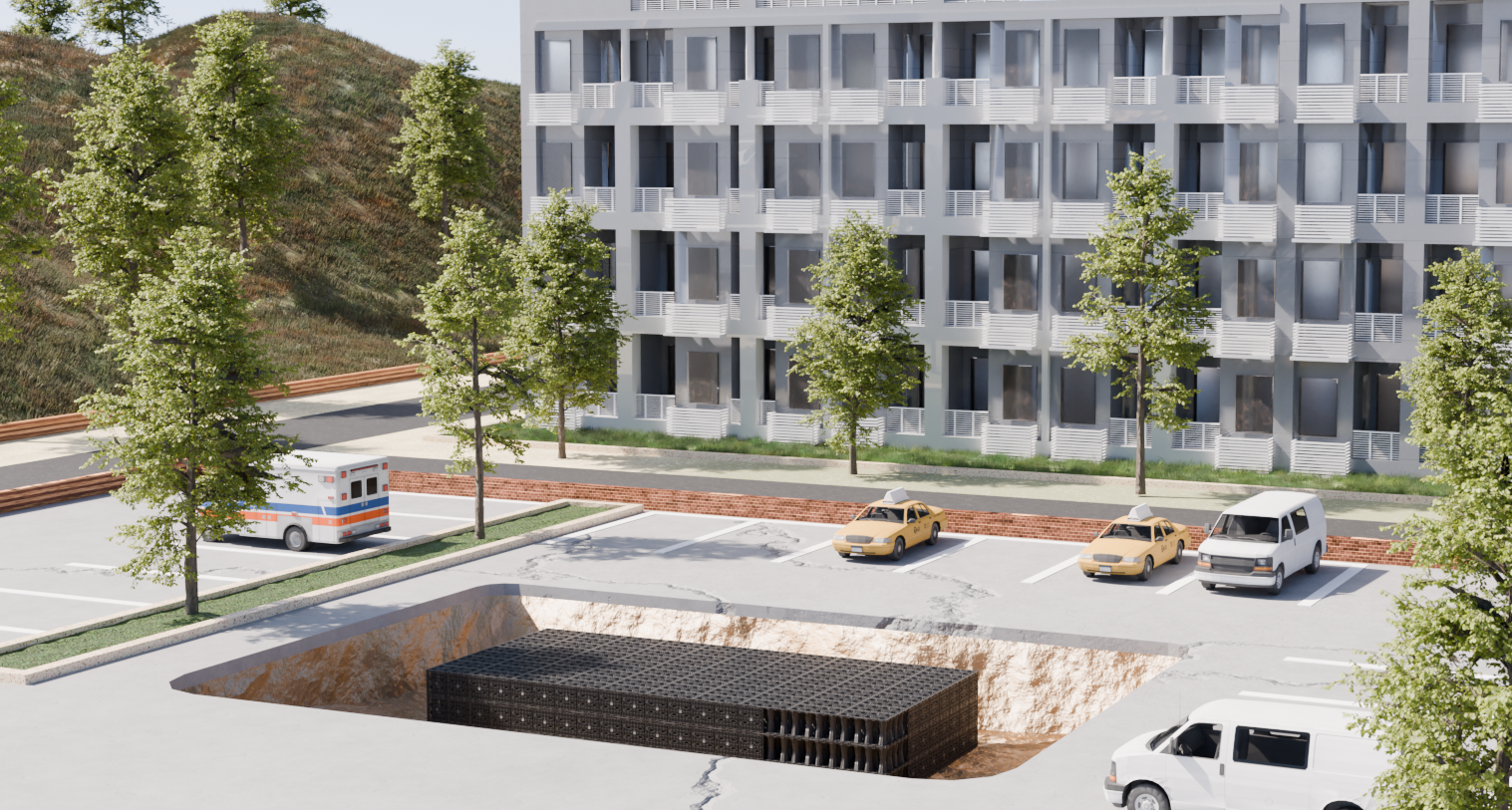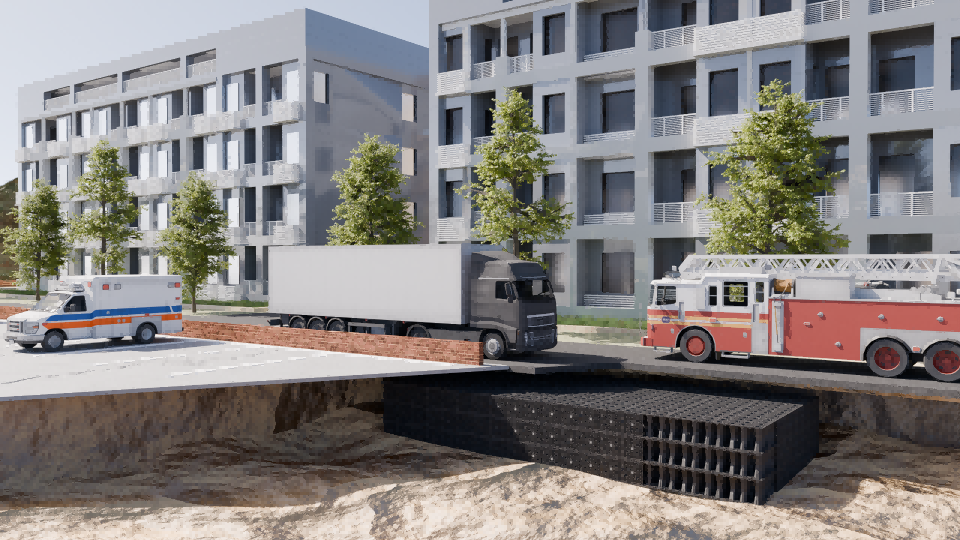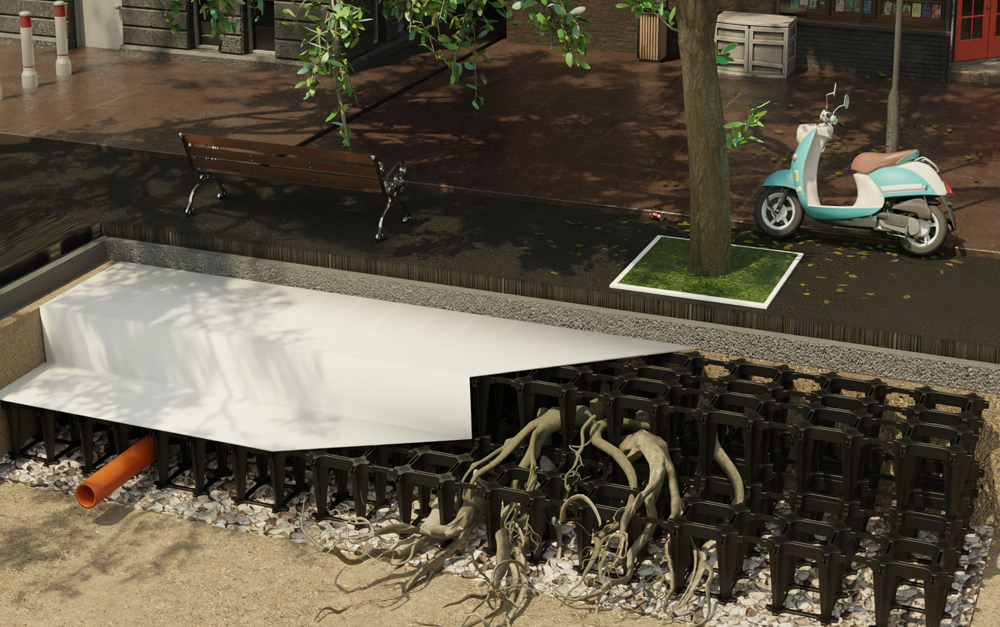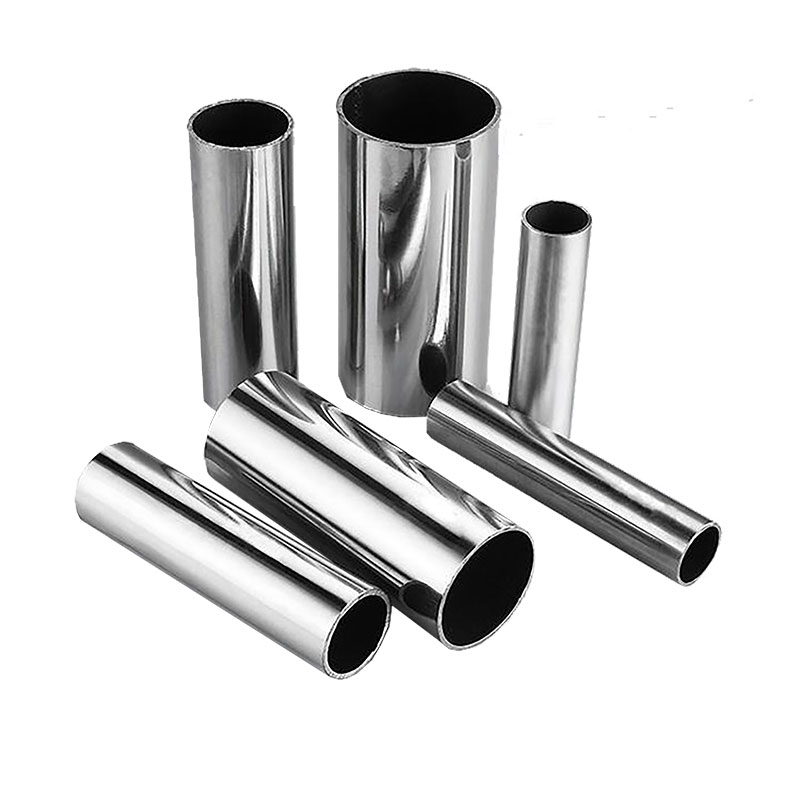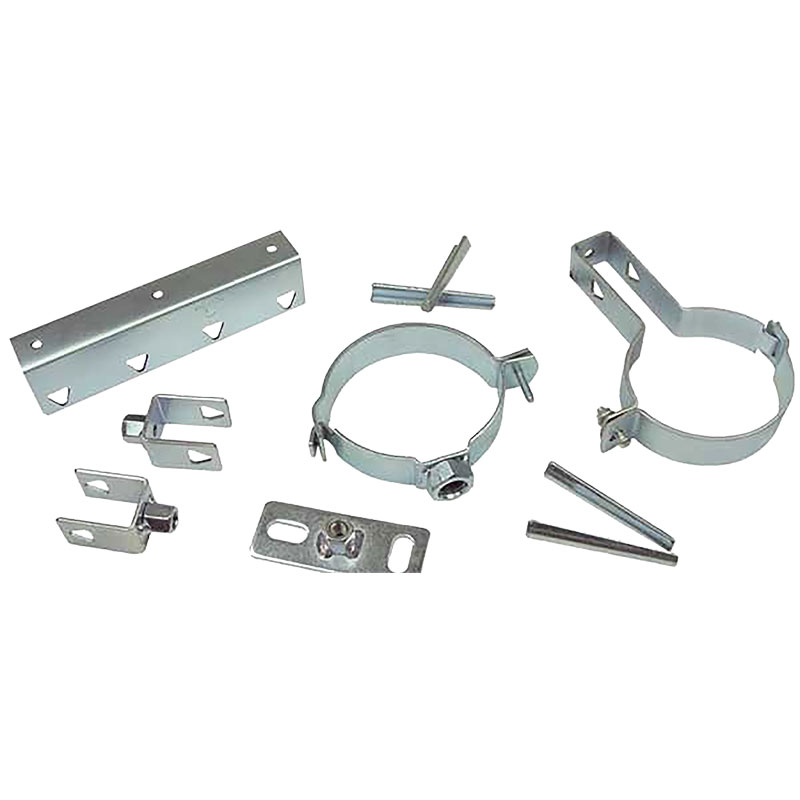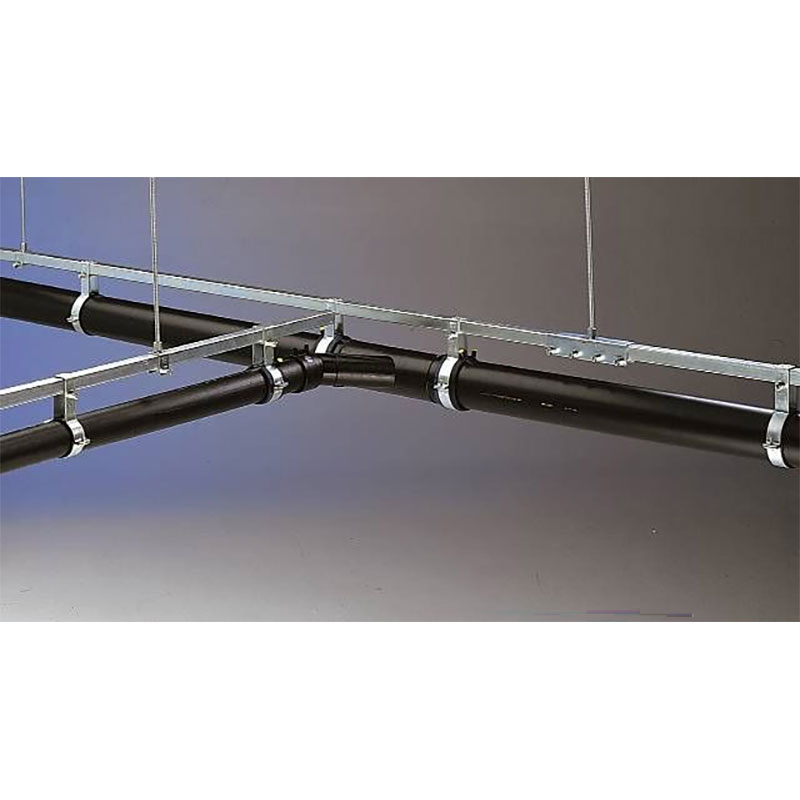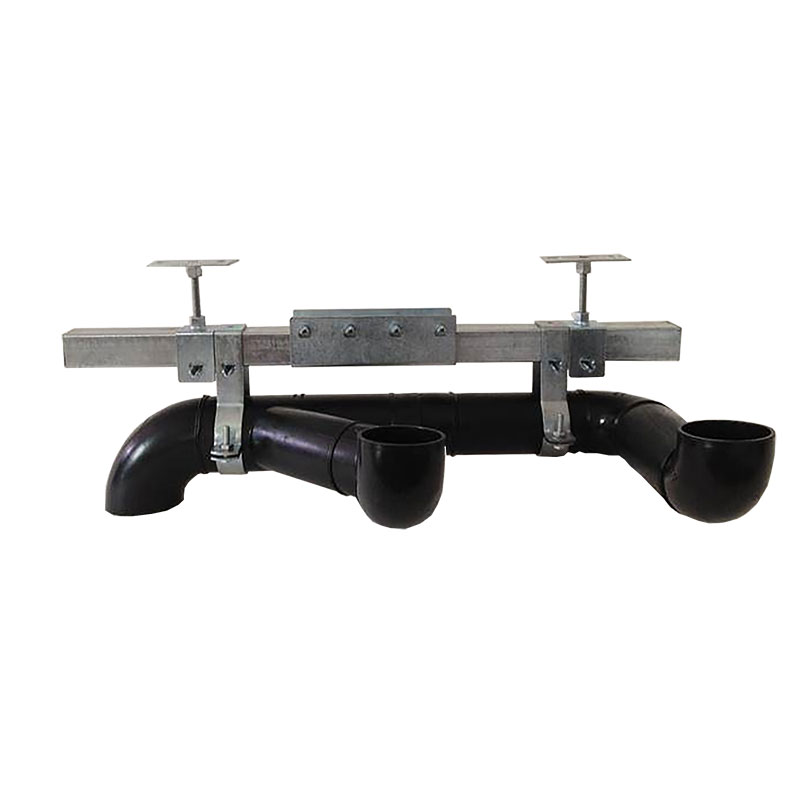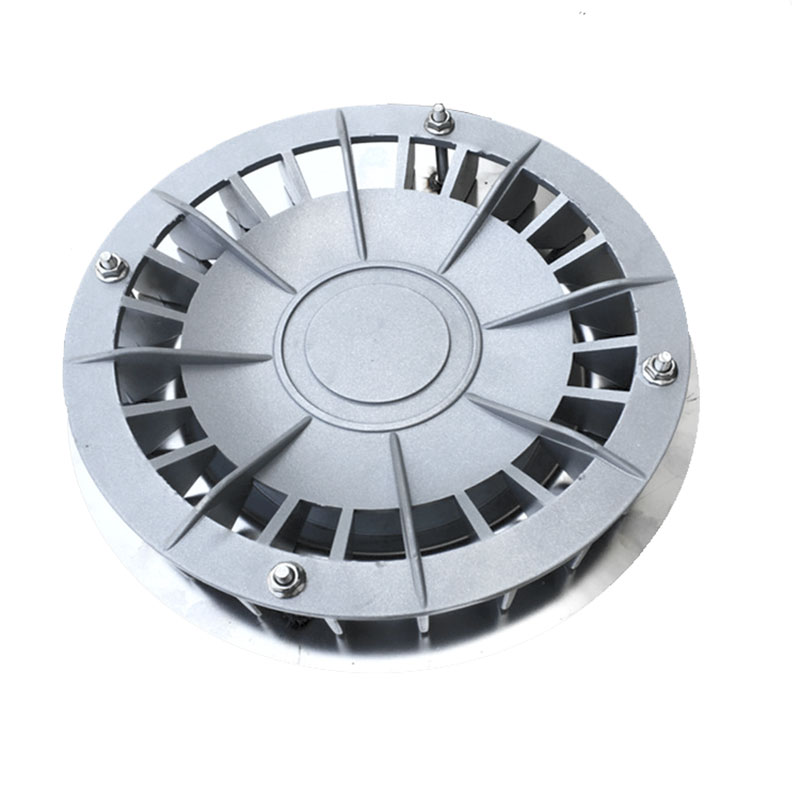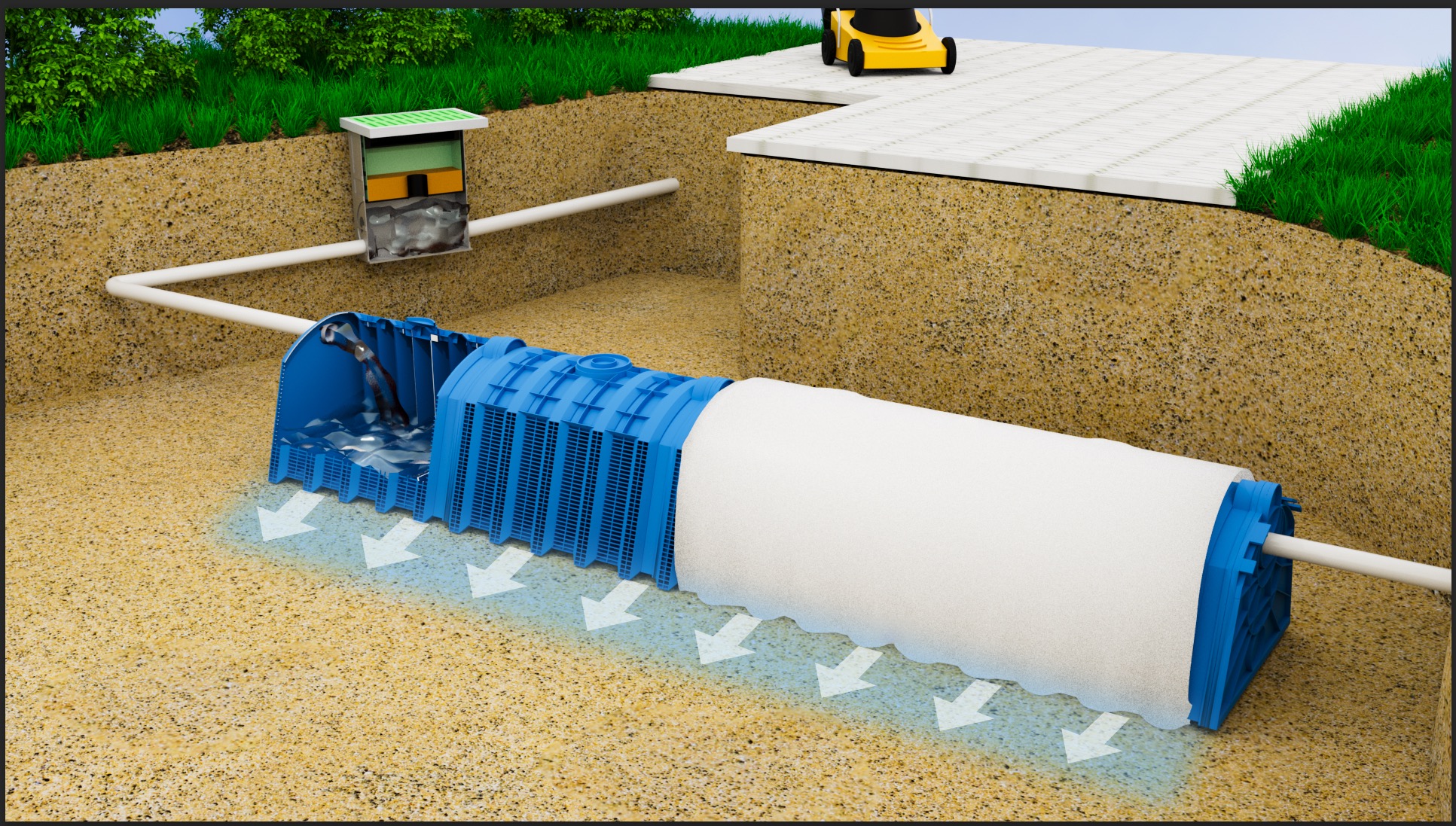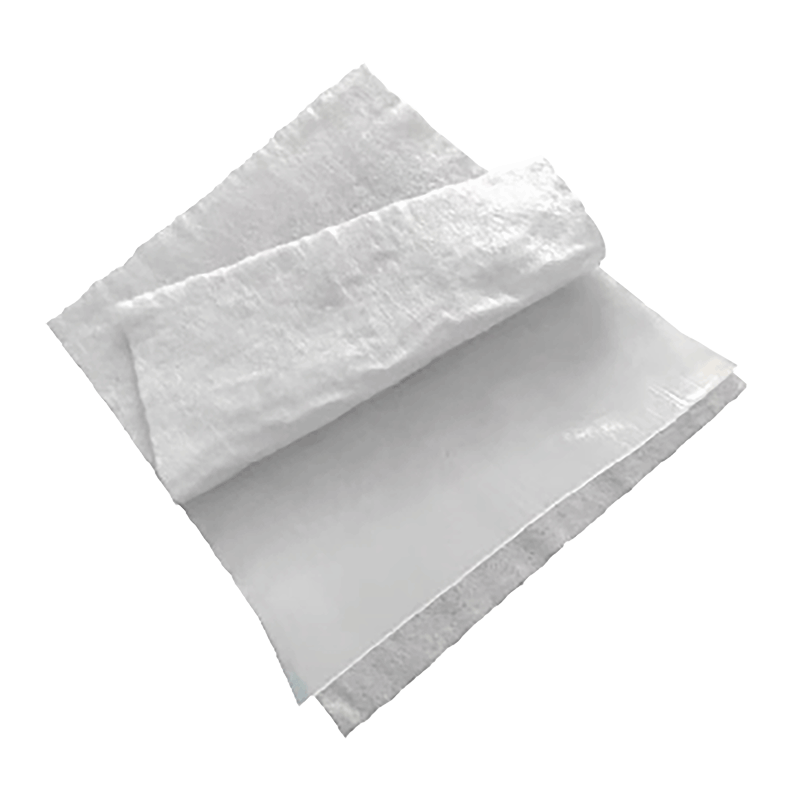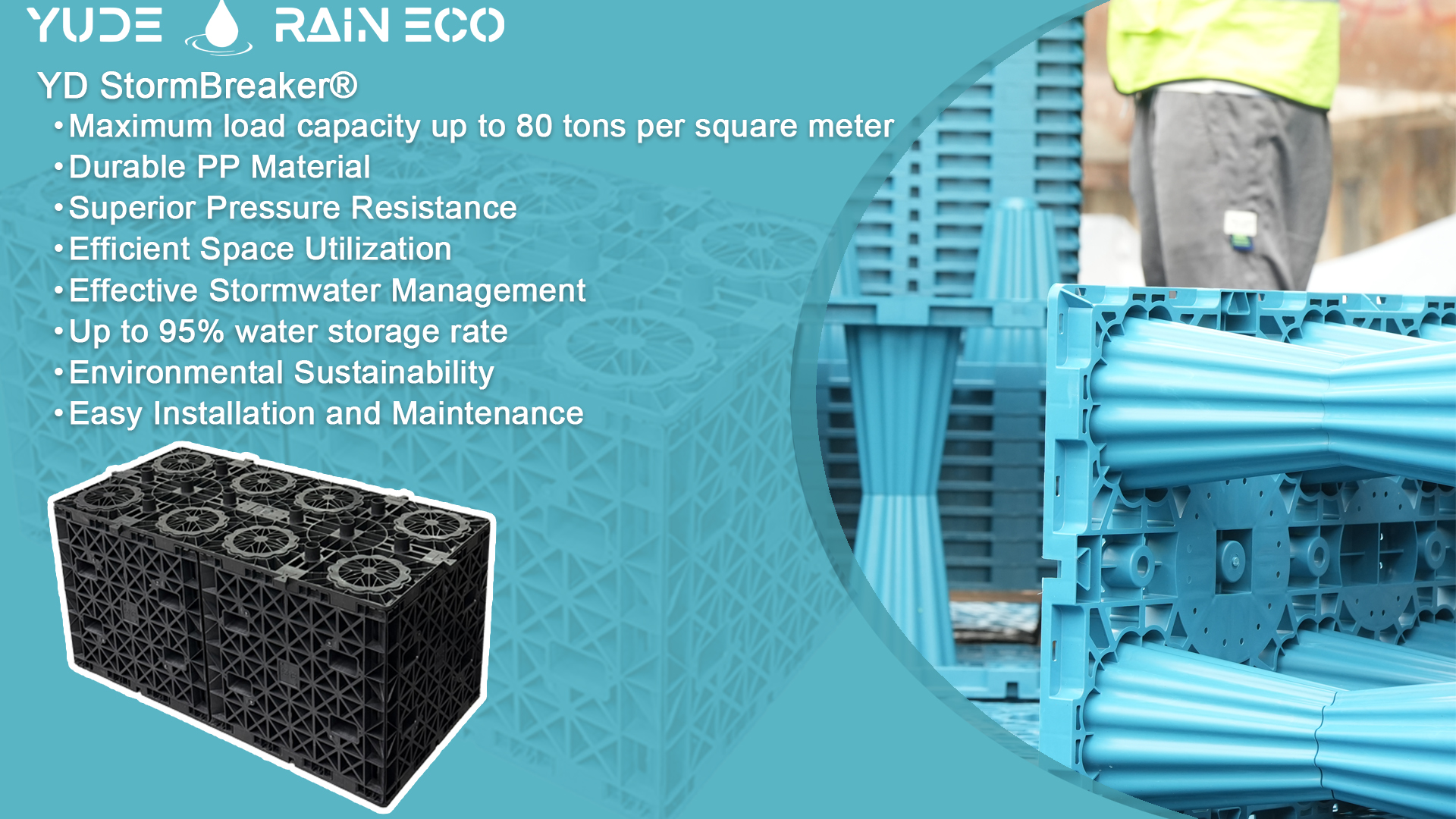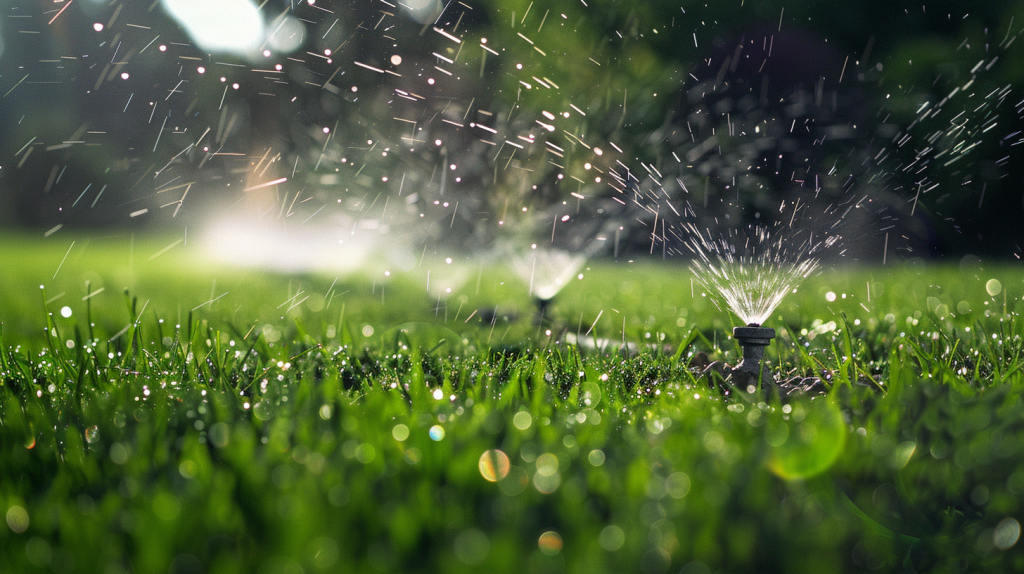In today’s rapidly urbanizing world, climate change and extreme weather events are putting immense pressure on urban infrastructure. Effective stormwater management is no longer optional—it is a necessity for ensuring resilience, water conservation, and environmental responsibility. This article explores the key differences between commercial and residential rainwater harvesting systems, the benefits of underground collection methods, and the critical components such as modular underground cisterns and infiltration systems.
1. Different of Commercial Rainwater Harvesting and Residential Rainwater Harvesting Solutions
Commercial and residential rainwater harvesting systems are designed to cater to different needs and scales.
1.1 Commercial Rainwater Harvesting Solutions
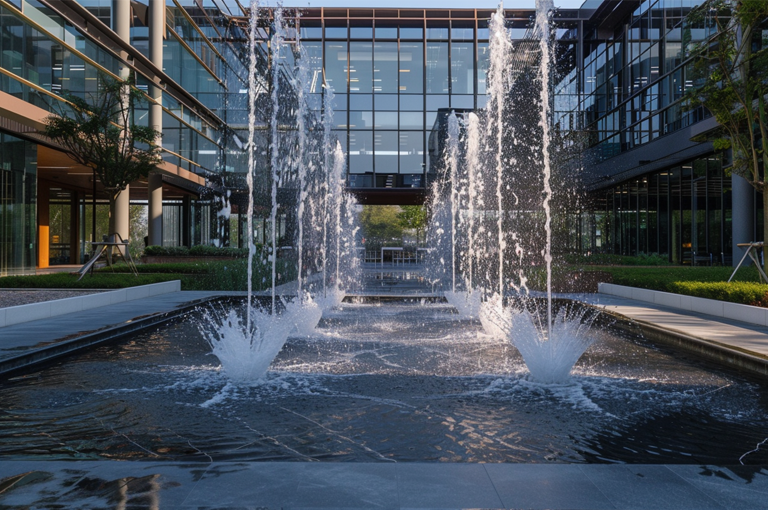
1.1.1 Scale and Complexity
Commercial rainwater harvesting systems are engineered to manage significantly larger volumes of water. These systems are designed for facilities such as office towers, shopping centers, manufacturing plants, and educational institutions. They typically include high-capacity underground tanks, first-flush diverters, advanced filtration modules, and automated pump systems. System integration with building management platforms ensures efficient water reuse and data-driven performance monitoring.
1.1.2 Applications and Strategic Benefits
These systems help commercial properties reduce reliance on municipal water, manage stormwater runoff to prevent site flooding, and comply with green building certifications like LEED and BREEAM. Harvested water is used for HVAC cooling towers, flushing, irrigation, and process water. Many jurisdictions now require commercial projects to implement water reuse or detention systems as part of urban stormwater control ordinances.
1.2 Residential Rainwater Harvesting Solutions

1.2.1 Simplicity and Affordability of Residential Rainwater Harvesting
Residential systems are generally compact and user-friendly. Designed for low maintenance and affordability, they typically consist of rooftop catchment areas, PVC guttering, mesh leaf screens, sediment traps, and storage tanks or rain barrels. Advanced households may also integrate pressure pumps and small-scale UV or carbon filters for reuse.
1.2.2 Benefits and Applications of Residential Rainwater Harvesting
For homeowners, these systems reduce monthly water bills and support sustainable landscaping. In regions prone to water restrictions or drought, residential rainwater systems provide a critical alternative source. Additionally, they promote environmental stewardship and climate awareness within communities.
2. What is Underground Rain Harvesting System?
Underground rain harvesting systems are a modern, space-efficient solution for urban water storage and management. By installing tanks and crates below the surface, properties can benefit from large storage capacity without compromising surface usability or aesthetics.
2.1 How Underground Rain Harvesting System Works ?
2.1.1 Collection and Storage
Rainwater is routed from the roof to a pre-filtration system and then into an underground cistern or modular storage tank. These tanks can be fabricated from concrete, HDPE, or reinforced fiberglass, and are built to resist soil pressure and root intrusion. Yude Rain Eco specializes in modular systems made from high-strength polypropylene for scalable and site-specific installation.
2.1.2 Integration with Landscaping
Underground systems can be seamlessly integrated into landscaping designs, freeing up valuable surface space. This makes them an excellent option for urban areas where space is at a premium. Additionally, these systems can be designed to complement the aesthetic of the surrounding environment, providing both functional and visual benefits.
2.2 Benefits of Underground Systems
2.2.1 Protection from Contamination
Underground systems protect the stored water from temperature fluctuations and sunlight, which can reduce the risk of algae growth and contamination. This ensures that the water remains clean and safe for its intended use.
2.2.2 Mitigation of Flooding and Soil Erosion
By reducing stormwater runoff, underground rain harvesting systems can help mitigate the risk of flooding and soil erosion. This is particularly important in urban areas where impermeable surfaces can exacerbate these issues.
Commonly Include Underground Cistern and Infiltration System
Underground rain harvesting systems often feature two key components: underground cisterns and infiltration systems.
2.2 Underground Cisterns
2.2.1 Design and Materials
Underground cisterns are large storage tanks installed below ground level to collect and store rainwater. They come in various sizes and materials, tailored to meet the specific needs of a property. Common materials include concrete, polyethylene, and fiberglass, each offering durability and longevity. Yude Rain Eco’s underground cisterns StormBreaker® (stormwater attenuation crates) are primarily made of polypropylene (PP), designed in a modular form to flexibly adapt to the drainage and storage needs of various buildings. This modular design enhances the efficiency and versatility of the system, making it suitable for a wide range of applications.
2.2.2 Filtration and Purification
Depending on end use, cisterns can be paired with sediment filters, carbon filters, or advanced purification systems. This ensures compliance with irrigation, toilet flushing, or potable reuse standards.
2.2.3 Applications and Benefits
Cisterns serve schools, farms, hospitals, malls, and homes. Their modularity allows for scaling based on water yield and footprint, making them ideal for both retrofits and new developments.
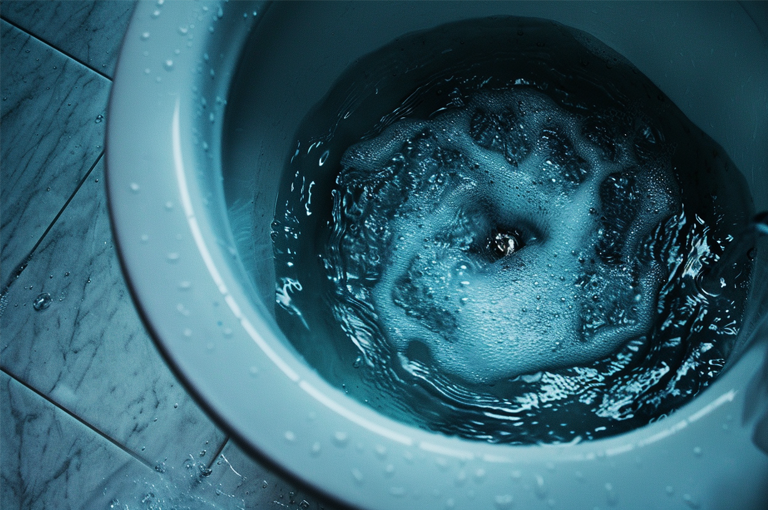
2.3 Infiltration Systems
2.3.1 Types of Infiltration Systems
Infiltration systems allow collected rainwater to percolate back into the ground, replenishing groundwater supplies and reducing surface runoff. Common types of infiltration systems include trenches, dry wells, and infiltration basins. These systems are designed to maximize the absorption of water into the soil, supporting groundwater recharge and maintaining the natural hydrological cycle.
2.3.2 Benefits and Environmental Impact of Underground Cisterns Infiltration Systems
Infiltration systems play a crucial role in managing stormwater by reducing surface runoff and preventing flooding. They also help in mitigating soil erosion and improving water quality by filtering pollutants through the soil. By replenishing groundwater supplies, infiltration systems contribute to the sustainability of local water resources.
Take Action with Yude Rain Eco
As the impacts of climate change continue to intensify, effective stormwater management has never been more critical. Whether you are a commercial property owner seeking to reduce operational costs and environmental footprint, or a homeowner aiming to conserve water and protect your property from flooding, rainwater harvesting systems offer a sustainable and practical solution. Yude Rain Eco is here to help you achieve these goals.
3. Why Choose Yude Rain Eco?
Yude Rain Eco specializes in providing comprehensive rainwater management solutions tailored to meet the unique needs of both commercial and residential clients. With our expertise in rainwater harvesting systems, we offer a range of services including the design, installation, and maintenance of efficient and sustainable water management systems.
Our Solutions:
Commercial Rainwater Harvesting Solutions: Large-scale systems designed to manage significant volumes of water, reduce reliance on municipal water supplies, and support sustainable business practices.
Residential Rainwater Harvesting Solutions: Affordable and efficient systems for individual households, providing alternative water sources for gardening, laundry, and more.
Underground Rain Harvesting Systems: Space-saving and aesthetically pleasing solutions that protect water quality and reduce stormwater runoff.
Underground Cisterns and Infiltration Systems: Durable and effective components that ensure the long-term sustainability of your rainwater management system.
Ready to Transform Your Water Management Strategy?
Join governments, businesses, and homeowners around the world in rethinking stormwater. Reduce costs, increase resilience, and support climate-positive infrastructure with Yude Rain Eco.
- Schedule a consultation tailored to your site and goals
- Learn how modular rainwater systems can help your project meet environmental and regulatory targets
- Let’s build a sustainable future, one cistern at a time
Yude Rain Eco – Future-Proof Stormwater Solutions for a Changing Climate.

